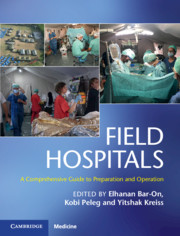Book contents
- Field Hospitals
- Field Hospitals
- Copyright page
- Contents
- Contributors
- Preface
- Section 1 History
- Section 2 Scenarios
- Section 3 Operational Considerations
- Section 4 Clinical Considerations
- Section 5 Additional Contextual Considerations
- Chapter 29 Forensic Medicine and Victim Identification in the Field Hospital Setting
- Chapter 30 Prehospital Care in the Disaster Setting
- Chapter 31 Long-term Deployment and Continuity of Care
- Chapter 32 Ethical Dilemmas in Field Hospital Deployments
- Chapter 33 Legal Issues in Field Hospital Deployments
- Index
- Plate Section (PDF Only)
- References
Chapter 33 - Legal Issues in Field Hospital Deployments
from Section 5 - Additional Contextual Considerations
Published online by Cambridge University Press: 09 January 2020
- Field Hospitals
- Field Hospitals
- Copyright page
- Contents
- Contributors
- Preface
- Section 1 History
- Section 2 Scenarios
- Section 3 Operational Considerations
- Section 4 Clinical Considerations
- Section 5 Additional Contextual Considerations
- Chapter 29 Forensic Medicine and Victim Identification in the Field Hospital Setting
- Chapter 30 Prehospital Care in the Disaster Setting
- Chapter 31 Long-term Deployment and Continuity of Care
- Chapter 32 Ethical Dilemmas in Field Hospital Deployments
- Chapter 33 Legal Issues in Field Hospital Deployments
- Index
- Plate Section (PDF Only)
- References
Summary
The deployment of field hospitals to meet the medical needs of the affected population is a common occurrence in the aftermath of many emergencies. Their use may give rise to a myriad of legal issues; from obtaining access to populations in need and protecting hospital staff and patients, to ensuring the suitability and standards of medical assistance provided. There is no single, comprehensive legal framework governing such matters. Instead, relevant rules, principles, and guidance may be found in a variety of national, regional, and international laws, as well as in nonbinding guidelines and standards (sometimes referred to as “soft law”). This chapter focuses primarily on the applicable international law, as well as on relevant soft-law instruments.
- Type
- Chapter
- Information
- Field HospitalsA Comprehensive Guide to Preparation and Operation, pp. 313 - 322Publisher: Cambridge University PressPrint publication year: 2020



